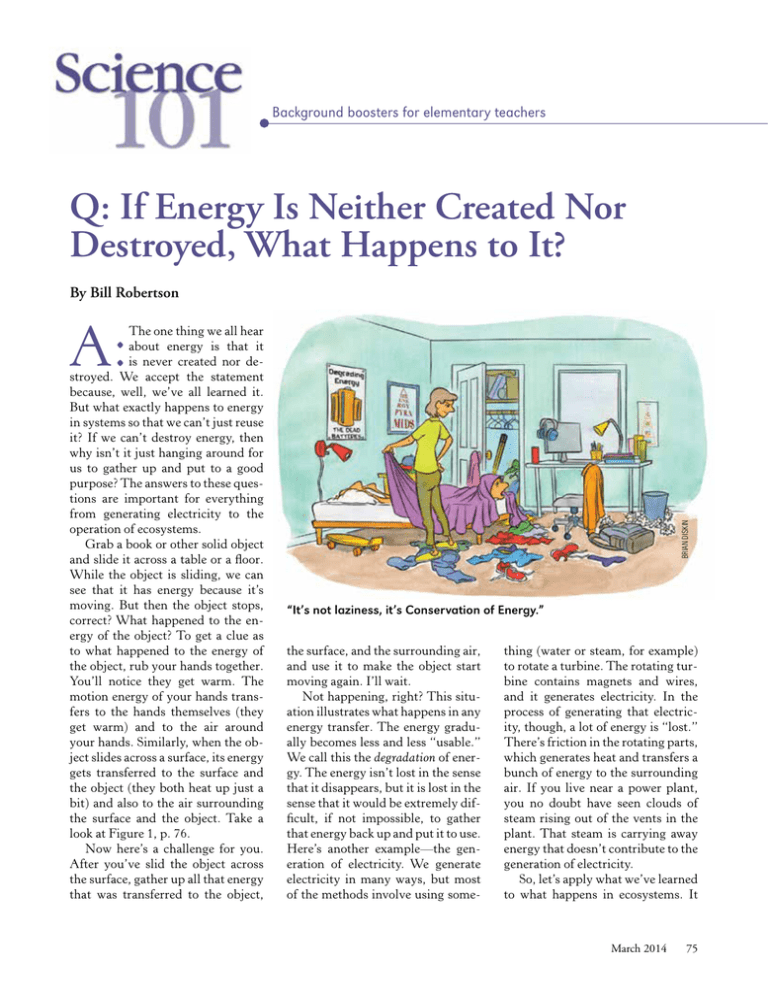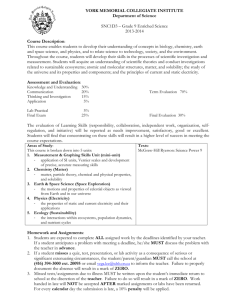Q: If Energy Is Neither Created Nor Destroyed, What Happens to It?
advertisement

Background boosters for elementary teachers Q: If Energy Is Neither Created Nor Destroyed, What Happens to It? By Bill Robertson BRIAN DISKIN A: The one thing we all hear about energy is that it is never created nor destroyed. We accept the statement because, well, we’ve all learned it. But what exactly happens to energy in systems so that we can’t just reuse it? If we can’t destroy energy, then why isn’t it just hanging around for us to gather up and put to a good purpose? The answers to these questions are important for everything from generating electricity to the operation of ecosystems. Grab a book or other solid object and slide it across a table or a floor. While the object is sliding, we can see that it has energy because it’s moving. But then the object stops, correct? What happened to the energy of the object? To get a clue as to what happened to the energy of the object, rub your hands together. You’ll notice they get warm. The motion energy of your hands transfers to the hands themselves (they get warm) and to the air around your hands. Similarly, when the object slides across a surface, its energy gets transferred to the surface and the object (they both heat up just a bit) and also to the air surrounding the surface and the object. Take a look at Figure 1, p. 76. Now here’s a challenge for you. After you’ve slid the object across the surface, gather up all that energy that was transferred to the object, “It’s not laziness, it’s Conservation of Energy.” the surface, and the surrounding air, and use it to make the object start moving again. I’ll wait. Not happening, right? This situation illustrates what happens in any energy transfer. The energy gradually becomes less and less “usable.” We call this the degradation of energy. The energy isn’t lost in the sense that it disappears, but it is lost in the sense that it would be extremely difficult, if not impossible, to gather that energy back up and put it to use. Here’s another example—the generation of electricity. We generate electricity in many ways, but most of the methods involve using some- thing (water or steam, for example) to rotate a turbine. The rotating turbine contains magnets and wires, and it generates electricity. In the process of generating that electricity, though, a lot of energy is “lost.” There’s friction in the rotating parts, which generates heat and transfers a bunch of energy to the surrounding air. If you live near a power plant, you no doubt have seen clouds of steam rising out of the vents in the plant. That steam is carrying away energy that doesn’t contribute to the generation of electricity. So, let’s apply what we’ve learned to what happens in ecosystems. It March 2014 75 might seem an odd transition, but energy considerations permeate all areas of science. At some point in your learning or teaching, you probably encountered what’s known as ecological pyramids or energy pyramids. Those are diagrams that show the relative numbers of primary producers, such as plants; primary consumers, such as animals that eat plants; secondary consumers, such as animals that eat the animals that eat plants; and tertiary consumers, such as animals that eat the animals that eat ... well, you get the picture. In case you don’t get the picture, there’s a drawing in Figure 2. What might not be obvious in Figure 2 is why, exactly, it’s a pyramid. Why are there lots and lots of primary producers, fewer primary consumers, and fewer and fewer animals on up to the top? Let’s just consider a hawk that consumes a mouse. The hawk, by using its digestive system and various bodily processes, obtains energy from the mouse. But the hawk doesn’t obtain all the energy the mouse expended in its lifetime—the energy the mouse used to get energy from grains, the energy the mouse expended in motion, and the energy the mouse radiated away as heat throughout its lifetime. In other words, a lot of the mouse’s energy is “lost” to the hawk—another example of the degradation of energy. Similarly, all organisms at a higher level only benefit from a small fraction of the total energy from organisms at a lower level. All of this “lost” energy means that it takes a lot of organisms at a lower level to support a few organisms at a higher level. Hence, we get the pyramid. This is actually a good thing. If the energy at each level transferred 76 Science and Children FIGURE 1. The motion energy of sliding the book transfers to the surrounding air, the surface, and the book itself. All of them heat up. FIGURE 2. Ecological Pyramid Tertiary consumers Secondary consumers Primary consumers Producers completely to organisms at the next level up, we’d have a whole lot more mice than we do and about as many hawks as we have mice. It would get crowded! Okay, here’s another challenge for you. You want to light a lightbulb, so you need an energy source. Head to your nearest pool or lake or ocean. There’s a whole bunch of energy there because all of the water molecules are moving around randomly. If we’re talking about, say, 50 cubic meters of ocean, that’s a great deal of energy! So, use all that energy to light your lightbulb. Putting a lightbulb in the ocean doesn’t make it light, so we’d have to figure out a different way. We could gather up that 50 cubic meters of ocean, make it flow through a turbine, and use the resulting electricity to light the bulb. But of course that would require a great deal of energy input from us, much more energy than we’d get in the form of electricity. The lesson here is that you can use random energy such as that found in the ocean or that found in the motion of air molecules around you, but it requires a large input of extra energy to do so. And in fact, we’d “lose” a whole bunch of energy while doing that. The energy of people’s muscles, the heat radiated away from people’s bodies, and any friction involved in our process, results in even more of that “lost” or degraded energy. The bottom line is that we can’t win. Even when we try to gather up degraded energy, we end up creating more degraded energy. There’s basically one direction for the flow of energy in the universe—toward less and less useful forms (or more degraded forms) of energy. Another way of saying that is that energy in the universe goes from organized to disorganized. So maybe you’re wondering what this means for the ultimate fate of the universe. There are speculations that the universe will eventually reach heat death, in which all of the energy in the universe becomes so degraded that it will be impossible to sustain life or any other organized process. Fun to think about, but it’s not as simple as that. Whether or not we end in heat death has to do with the expansion rate of the universe, the role of gravity, and whether or not we’re correct on that big bang thing. And even if we were to end in a heat death, it wouldn’t happen for billions of years. You have time to plan. n Bill Robertson (wrobert9@ix.net com.com) is the author of the NSTA Press book series, Stop Faking It! Finally Understanding Science So You Can Teach It. Visit the NSTA Science Store at www.nsta.org/store to see all of Bill Robertson’s books &UDQN,W8S &UHDWHXSWRYROWVRIGLUHFWFXUUHQWZLWKWKHWXUQRIDFUDQN 6FLHQFH)LUVW ZZZVFLHQFHILUVWFRP +DQG*HQHUDWRU /LJKWDEXOEZLWKRXWEDWWHULHVDOOLWWDNHVLVDOLWWOHPXVFOH/RZ YROWDJHSRZHUVRXUFHLQFOXGHVSODVWLFKRXVLQJDQGLQVWUXFWLRQV $WWDFKDEOHHOHFWULFFRUGLVSRODULW\FRGHGZLWKDOOLJDWRUFOLSV March 2014 77

